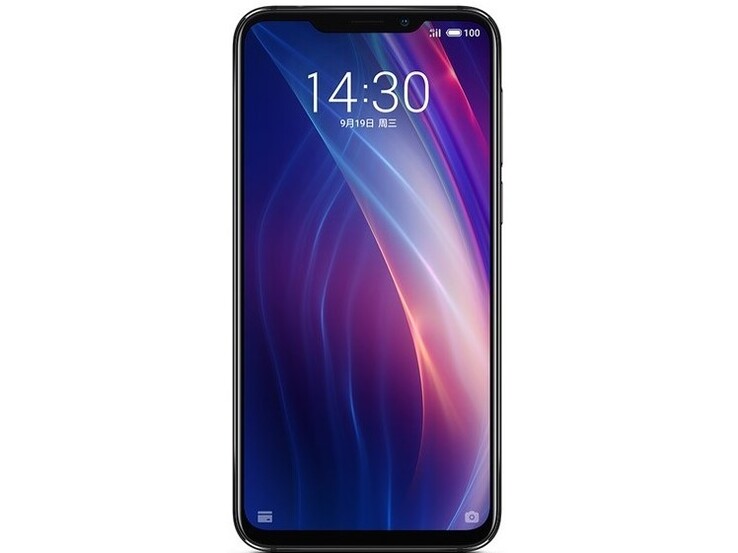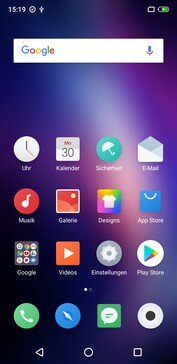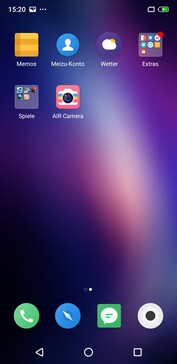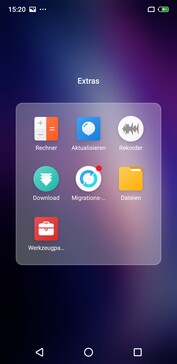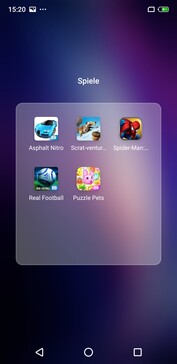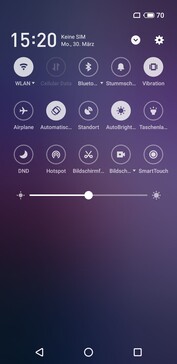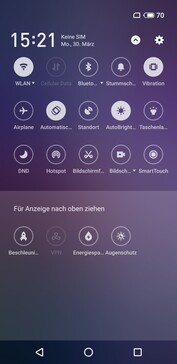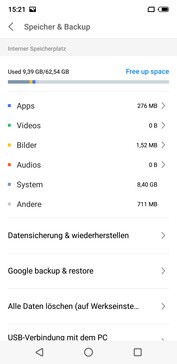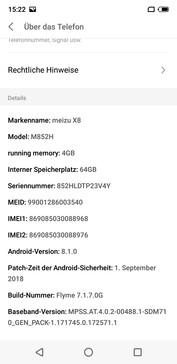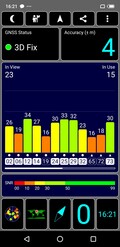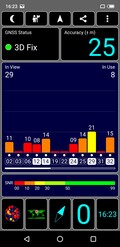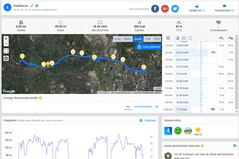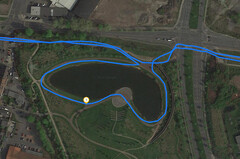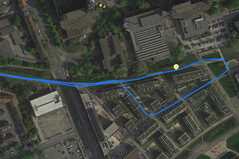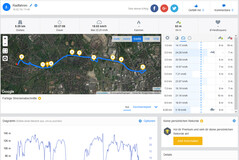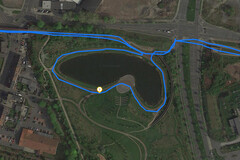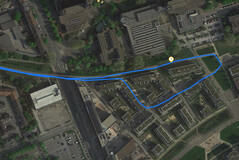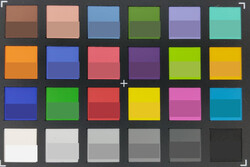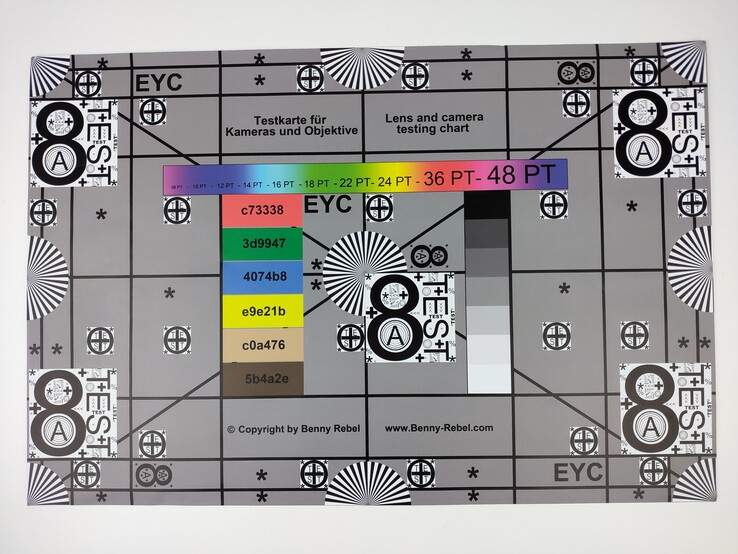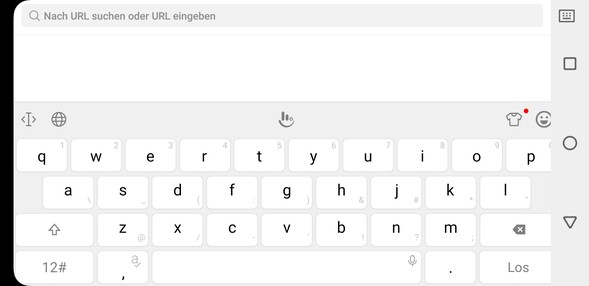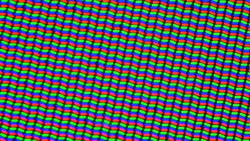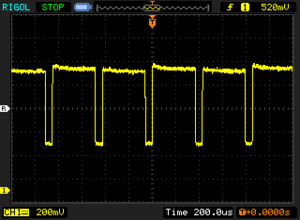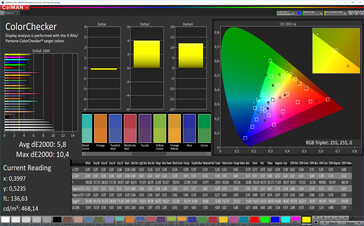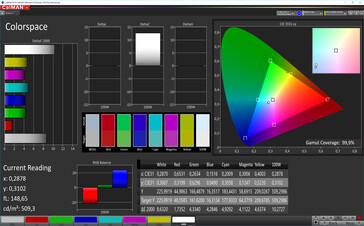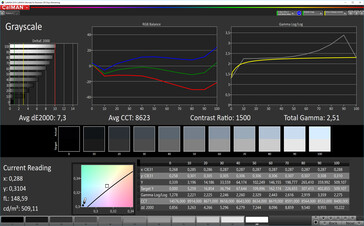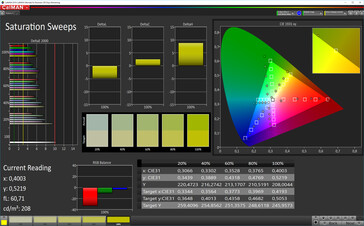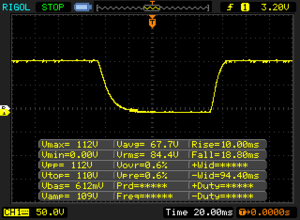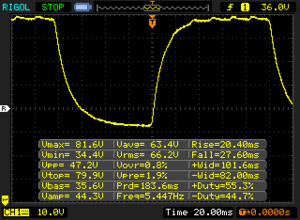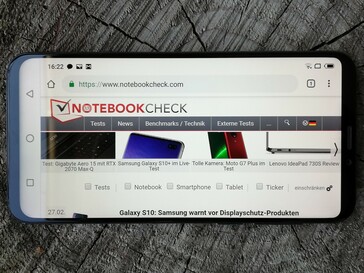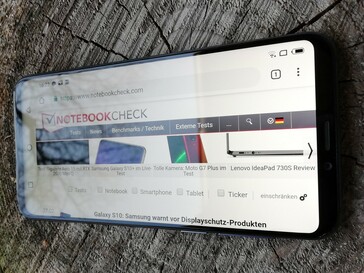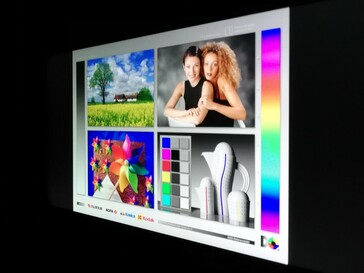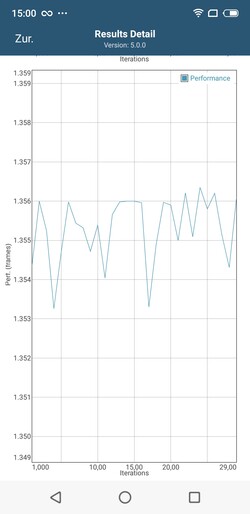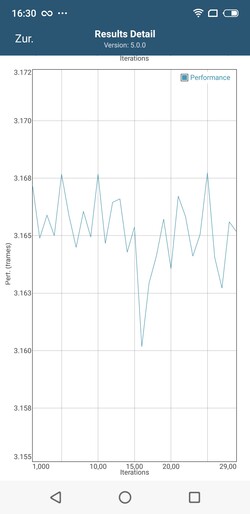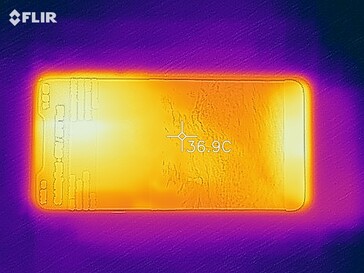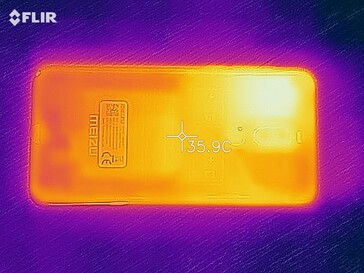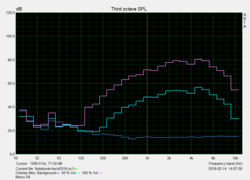Meizu X8 Smartphone Review
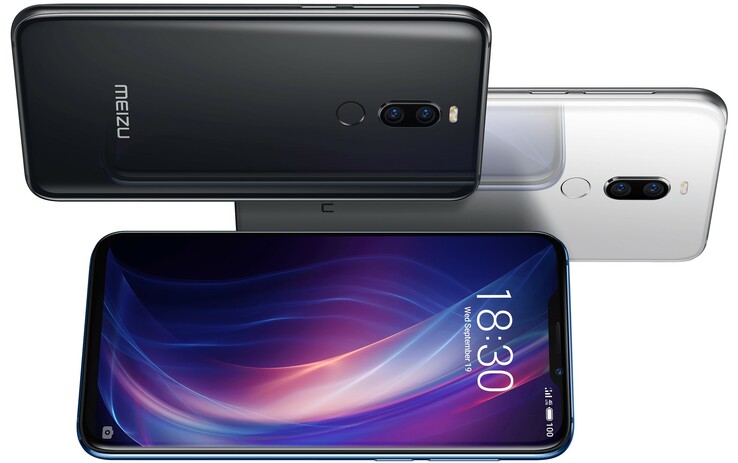
Attentive readers of Notebookcheck may have noticed the name Meizu before. Whether it be smartphones without buttons, high-resolution dual cameras or powerful midrange offerings, Meizu devices have always offered something different on paper at least. The Meizu X8 has now arrived at our offices, so we can look at the powerful mid-ranger more closely.
The hardware looks promising with a Qualcomm Snapdragon 710 SoC at the centre of things, which integrates a Qualcomm Adreno 616 GPU. Meizu complements the SoC with 4 GB RAM, but there is a 6 GB model if 4 GB is not enough for you. The 4 GB model also has 64 GB of eMMC flash storage, while the 6 GB model has 128 GB of storage. Both models have a 3.5 mm headphone jack, a fingerprint sensor, a mono speaker and a USB Type-C port too. Our review unit is the 4 GB model, which currently sells online for around 280 Euros (~$318).
We have chosen to compare the X8 against comparably priced midrange smartphones. Our comparison devices will include the Honor 10 Lite, OUKITEL U23, Umidigi Z2 Pro and the Xiaomi Mi 8 Lite.
Case
The X8 has a modern design and a glass back that also houses the dual rear-facing cameras, the LED flash and the fingerprint sensor. The X8 has a metal frame that looks premium and feels stable. The transitions between materials are tight and even across our review unit. Meizu offers the X8 in black, blue and grey, which refers to both the frame and the back glass. It is worth noting that the power and volume buttons have some play in their housings, although the SIM card slot sits flush and firmly in the frame on the left-hand side of the device.
The X8 has a comparatively high screen-to-body ratio with its narrow bezels and correspondingly has a smaller footprint than our comparison devices. Our review unit is also lighter than our comparison devices, but it is marginally thicker than the Xiaomi Mi 8 Lite. Overall, the X8 feels comfortable in our hands thanks to its rounded edges, and it is relatively light too.
Connectivity
Meizu has equipped the X8 with a Snapdragon 710 SoC that integrates an Adreno 616 GPU, while our review unit also has 4 GB of RAM and 64 GB of eMMC flash storage. Alternatively, there is a 6 GB RAM and 128 GB storage version as we mentioned earlier. The X8 has dual-SIM functionality too, but the device does not support microSD expansion.
The Type-C port operates at the USB 2.0 standard, which delivers slower transfer speeds than USB 3.1 Gen1 or Gen2 ports. The inclusion of a headphone jack is welcome, as is a fingerprint reader. The lack of NFC is disappointing though.
Software
The X8 ships with Android 8.1 Oreo, while our review unit arrived with September 2018 security patches. Meizu adds its Flyme OS atop of 8.1 Oreo; our review unit runs version 7.1.7.0G, for reference. Flyme makes only minor visual adjustments compared to stock Android and restructures the settings menu, so it should not take long to acclimatise to navigating through the OS.
Oddly, some language packs like German are missing translations, which leaves UI elements untranslated. The keyboard app must also be manually switched to a different layout even if a language pack is applied. Meizu preinstalls some apps too, but these can be uninstalled.
Unfortunately, the X8 cannot stream services like Amazon Prime Video or Netflix in HD as it lacks the sufficient DRM certification. Only devices that are DRM Widevine L1-certified can stream HD content, but the X8 is only L3-certified. Moreover, the certification cannot be changed via a software update, so you will only be able to stream Amazon or Netflix platforms such as Netflix or Amazon Prime in standard definition (SD).
Communication & GPS
The X8 supports most GSM, 3G and LTE frequencies, while it also utilises LTE Cat.12 for up to 600 Mb/s download and 100 Mb/s upload speeds. The X8 supports dual-SIM LTE too, but it does not have voice over LTE (VoLTE) or Wi-Fi calling (VoWiFi) functionality.
The device also supports Bluetooth 5.0 and modern Wi-Fi standards up to IEEE 802.11ac, which allows it to connect to 2.4 GHz or 5 GHz networks. Our review unit achieved above-average results in iperf3 Client Wi-Fi tests and finished in the upper midfield in our comparison tables. The X8 averaged 309 Mb/s in the download test and 252 Mb/s in the upload portion of iperf3 Client.
| Networking | |
| iperf3 transmit AX12 | |
| Umidigi Z2 Pro | |
| Xiaomi Mi 8 Lite | |
| Meizu X8 | |
| Oukitel U23 | |
| Honor 10 Lite | |
| iperf3 receive AX12 | |
| Xiaomi Mi 8 Lite | |
| Umidigi Z2 Pro | |
| Meizu X8 | |
| Oukitel U23 | |
| Honor 10 Lite | |
The X8 uses BeiDou, GLONASS and GPS for location services and achieves a satellite fix of up to four metres outside. Location accuracy dropped to 25 metres when we tested our review unit inside, but this is still an acceptable value for a midrange smartphone.
We also subjected the X8 to a bike ride to compare its location accuracy against our reference Garmin Edge 500. Our review unit deviated by 30 metres compared to the route that the Garmin plotted, which is impressively accurate. The X8 generally did a good job at recording our route accurately through corners, but it occasionally wavered when we were cycling along a straight road. Overall though, the X8 is accurate enough for all general navigation tasks.
Telephone Features & Call Quality
Meizu preinstalls its suite of telephony apps, but the Phone app functions just as other apps do with quick access to the numeric keypad and your contacts. There are missing translations here too, but these should not interfere with using the device.
Our review unit has decent call quality with both sides of the call sounding clear throughout our tests. The microphone does a good job at filtering background noise, and you should have no issues with making calls even from noisy environments.
Cameras
The X8 has impressive cameras, at least on paper. Meizu has equipped the device with a 20 MP front-facing sensor that has an f/2.0 aperture and dual rear-facing cameras. The former takes detailed photos and separates objects clearly. However, photos generally look too overexposed for our liking and colour reproduction is rather dull. The default camera app has a beauty mode and numerous filters like many camera apps. There is no manual mode though.
The main rear-facing camera is a 12 MP sensor that has an f/1.9 aperture, which is supported by a 5 MP secondary sensor. Our review unit takes decent photos even in uneven lighting conditions, but objects lack separation when looked at closely and there is noticeable image noise.
Macro photos have plenty of detail though, and the 12 MP sensor does a good job at delineating between areas of colour, although objects look more blurry the closer they are to the edge of the photo. Low-light pictures look good on the surface too, as demonstrated below by scene 3. The toy bunny and the Android figurine are exposed well, while the electric candle does not look any more overexposed than the LG V40 manages. However, the picture is a blurry mess when looked at more closely, with the pattern on the t-shirt being completely lost and the fur lacking any depth.
The default camera app has a manual mode that contains settings for adjusting the brightness, focus, shutter speed, ISO, and white balance, which may allow you to capture better low-light shots. The resolution is fixed though, and you can only switch between shooting in 4:3, 16:9 or 18:9.
Video-recordings are equivalent in quality to and have the same limitations as photos. The X8 has an image stabiliser though, which compensates for a small amount of camera shake. The default camera app has options for setting the resolution to 480p, 720p, 1080p or 4K. 480p is shot in 4:3, for reference, while the camera app records in the other three resolutions at 16:9. There are no manual or slow-motion modes.
We also subjected our review unit to further camera tests under controlled lighting conditions. The X8 reproduces colours too brightly compared to the ColorChecker Passport reference colours with exception to black tones, which it reproduces almost perfectly. The device also reproduces our test chart sharply. Fine details and structures are visible across the entire picture, although contrast levels drop off in the lower corners of the chart.
Accessories & Warranty
Meizu includes a power supply, a charging cable and a SIM tool in the box along with some legal and warranty information. The company does not currently sell any X8 specific accessories, but it does sell headphones, power banks and a smart personal scale.
The X8 comes with 12 months manufacturer’s warranty. Meizu has only a handful of service centres worldwide though, so sending the device back for a warranty repair may end up becoming a costly and lengthy process. Hence, we would suggest researching the pitfalls of importing a device from China before you decide to buy the X8.
Generally, we would recommend purchasing any device from a trusted retailer that also supplies its own warranty. Please see our Guarantees, Return policies and Warranties FAQ for country-specific information.
Input Devices & Operation
Meizu preinstalls TouchPal as the default keyboard on the X8, which functions much like other keyboards. You can always install another keyboard, many of which are downloadable from the Google Play Store.
Our review unit’s touchscreen responded well throughout testing, but occasionally it would not recognise our fingers if they were too dry or if we tried to press something too quickly. The glass covering the touchscreen has a smooth finish on which it is easy to perform multi-finger gestures like drag and drop movements.
The accelerometer generally worked well throughout our tests too, but we cannot say the same thing for the fingerprint sensor. The sensor typically recognised our fingers immediately, but it occasionally took two attempts before our review unit would unlock.
Display
The X8 has a 6.15-inch IPS display that operates natively at 2220x1080. Our review unit achieved an average maximum brightness of 511 cd/m² according to X-Rite i1Pro 2, which is between 9% and 24% brighter than our comparison devices. Similarly, the device achieved 518 cd/m² with its ambient light sensor activated, which rose to 527 cd/m² in the more realistic APL50 test. The display is 86% evenly lit too, which is on par with our comparison devices.
| |||||||||||||||||||||||||
Brightness Distribution: 86 %
Center on Battery: 520 cd/m²
Contrast: 1625:1 (Black: 0.32 cd/m²)
ΔE ColorChecker Calman: 5.8 | ∀{0.5-29.43 Ø4.78}
ΔE Greyscale Calman: 7.3 | ∀{0.09-98 Ø5}
99.9% sRGB (Calman 2D)
Gamma: 2.51
CCT: 8623 K
| Meizu X8 IPS, 2220x1080, 6.2" | Xiaomi Mi 8 Lite IPS, 2280x1080, 6.3" | Oukitel U23 IPS, 2246x1080, 6.2" | Honor 10 Lite IPS, 2340x1080, 6.2" | Umidigi Z2 Pro IPS, 2246x1080, 6.2" | |
|---|---|---|---|---|---|
| Screen | 8% | 25% | 6% | -19% | |
| Brightness middle (cd/m²) | 520 | 421 -19% | 472 -9% | 467 -10% | 479 -8% |
| Brightness (cd/m²) | 511 | 389 -24% | 459 -10% | 446 -13% | 466 -9% |
| Brightness Distribution (%) | 86 | 85 -1% | 92 7% | 89 3% | 73 -15% |
| Black Level * (cd/m²) | 0.32 | 0.33 -3% | 0.13 59% | 0.58 -81% | 0.27 16% |
| Contrast (:1) | 1625 | 1276 -21% | 3631 123% | 805 -50% | 1774 9% |
| Colorchecker dE 2000 * | 5.8 | 3.4 41% | 5.5 5% | 1.5 74% | 8.2 -41% |
| Colorchecker dE 2000 max. * | 10.4 | 5.9 43% | 9.1 12% | 4.5 57% | 16.2 -56% |
| Greyscale dE 2000 * | 7.3 | 3.9 47% | 6.1 16% | 2.4 67% | 10.5 -44% |
| Gamma | 2.51 88% | 2.26 97% | 2.31 95% | 2.22 99% | 2.47 89% |
| CCT | 8623 75% | 7330 89% | 8152 80% | 6387 102% | 9193 71% |
* ... smaller is better
Screen Flickering / PWM (Pulse-Width Modulation)
| Screen flickering / PWM detected | 2315 Hz | ≤ 24 % brightness setting | |
The display backlight flickers at 2315 Hz (worst case, e.g., utilizing PWM) Flickering detected at a brightness setting of 24 % and below. There should be no flickering or PWM above this brightness setting. The frequency of 2315 Hz is quite high, so most users sensitive to PWM should not notice any flickering. In comparison: 53 % of all tested devices do not use PWM to dim the display. If PWM was detected, an average of 8111 (minimum: 5 - maximum: 343500) Hz was measured. | |||
The X8 has a comparatively high black value, which X-Rite i1Pro 2 measures at 0.32 cd/m², but the display’s high maximum brightness helps it achieve an impressive 1,625:1 contrast ratio. Colours generally are separated well too, but black tones have a slight grey haze to them.
We also subjected our review unit to CalMAN analysis, which demonstrated that colours have a distinct blue tint and are slightly redder than they should be. Meizu does include an option in Settings to adjust the colour temperature between hot and cold, which can somewhat correct for the colour reproduction inaccuracies. There is an eye-saver mode too that filters blue light to limit eye strain when using the X8 at night. The mode can be activated manually or timed to switch on between certain times.
Display Response Times
| ↔ Response Time Black to White | ||
|---|---|---|
| 28.8 ms ... rise ↗ and fall ↘ combined | ↗ 10 ms rise | |
| ↘ 18.8 ms fall | ||
| The screen shows relatively slow response rates in our tests and may be too slow for gamers. In comparison, all tested devices range from 0.1 (minimum) to 240 (maximum) ms. » 75 % of all devices are better. This means that the measured response time is worse than the average of all tested devices (20.2 ms). | ||
| ↔ Response Time 50% Grey to 80% Grey | ||
| 48 ms ... rise ↗ and fall ↘ combined | ↗ 20.4 ms rise | |
| ↘ 27.6 ms fall | ||
| The screen shows slow response rates in our tests and will be unsatisfactory for gamers. In comparison, all tested devices range from 0.165 (minimum) to 636 (maximum) ms. » 82 % of all devices are better. This means that the measured response time is worse than the average of all tested devices (31.6 ms). | ||
The X8 is easy to use outdoors thanks to its bright display, although reflections will make the screen look washed-out on sunny days. The device remains readable, but we would recommend finding a shady spot where possible. You should have no readability issues with using the X8 in the sun on most days though.
Our review unit also has stable viewing angles thanks to its IPS panel. We noticed no brightness, colour or image distortions even at acute viewing angles. Hence, the X8 should remain readable from practically any angle, and only strong reflections will obscure your view.
Performance
Meizu equips the X8 with a Qualcomm Snapdragon 710 SoC that integrates an Adreno 616 GPU, 4 GB of RAM and 64 GB of eMMC flash storage, which should combine to run even demanding apps smoothly. There is a 6 GB RAM and 128 GB of internal storage version, as we mentioned at the start of this review.
The X8 achieved impressive results in synthetic benchmarks and often finished first in our comparison tables, although occasionally the Umidigi Z2 Pro and the Xiaomi Mi 8 Lite relegate our review unit to second place. However, while the system remained mostly fluid throughout testing, apps would sometimes only open after the second or third press. These lags would appear for no reason too, so we are unsure whether this is a software or touchscreen-related issue.
Please note that we included the Lenovo Z5 Pro and the Nokia 8.1 to compare the X8 against other Snapdragon 710 SoC-powered devices. Our review unit competes well in this regard too and only finishes up to 10% behind in synthetic benchmarks. Most benchmark results are identical among the three devices though, so you can expect equivalent performance in daily use.
| PCMark for Android | |
| Work performance score (sort by value) | |
| Meizu X8 | |
| Xiaomi Mi 8 Lite | |
| Oukitel U23 | |
| Honor 10 Lite | |
| Umidigi Z2 Pro | |
| Lenovo Z5 Pro | |
| Nokia 8.1 | |
| Average Qualcomm Snapdragon 710 (7041 - 9345, n=6) | |
| Work 2.0 performance score (sort by value) | |
| Meizu X8 | |
| Xiaomi Mi 8 Lite | |
| Oukitel U23 | |
| Honor 10 Lite | |
| Umidigi Z2 Pro | |
| Lenovo Z5 Pro | |
| Nokia 8.1 | |
| Average Qualcomm Snapdragon 710 (6453 - 7460, n=6) | |
| Basemark GPU 1.1 | |
| 1920x1080 Vulkan Medium Offscreen (sort by value) | |
| Meizu X8 | |
| Umidigi Z2 Pro | |
| Lenovo Z5 Pro | |
| Nokia 8.1 | |
| Average Qualcomm Snapdragon 710 (11.4 - 13, n=3) | |
| Vulkan Medium Native (sort by value) | |
| Umidigi Z2 Pro | |
| Lenovo Z5 Pro | |
| Nokia 8.1 | |
| Average Qualcomm Snapdragon 710 (10.1 - 12.1, n=2) | |
| 1920x1080 OpenGL Medium Offscreen (sort by value) | |
| Meizu X8 | |
| Umidigi Z2 Pro | |
| Lenovo Z5 Pro | |
| Nokia 8.1 | |
| Average Qualcomm Snapdragon 710 (14.3 - 15.5, n=3) | |
| AnTuTu v7 - Total Score (sort by value) | |
| Meizu X8 | |
| Xiaomi Mi 8 Lite | |
| Oukitel U23 | |
| Honor 10 Lite | |
| Umidigi Z2 Pro | |
| Lenovo Z5 Pro | |
| Nokia 8.1 | |
| Average Qualcomm Snapdragon 710 (155113 - 169262, n=4) | |
| AnTuTu v6 - Total Score (sort by value) | |
| Meizu X8 | |
| Xiaomi Mi 8 Lite | |
| Oukitel U23 | |
| Umidigi Z2 Pro | |
| Lenovo Z5 Pro | |
| Nokia 8.1 | |
| Average Qualcomm Snapdragon 710 (135848 - 137693, n=3) | |
| VRMark - Amber Room (sort by value) | |
| Meizu X8 | |
| Umidigi Z2 Pro | |
| Lenovo Z5 Pro | |
| Nokia 8.1 | |
| Average Qualcomm Snapdragon 710 (1681 - 1708, n=3) | |
| Basemark ES 3.1 / Metal - offscreen Overall Score (sort by value) | |
| Meizu X8 | |
| Umidigi Z2 Pro | |
| Lenovo Z5 Pro | |
| Nokia 8.1 | |
| Average Qualcomm Snapdragon 710 (479 - 488, n=3) | |
| Average of class Smartphone (205 - 7731, n=36, last 2 years) | |
The X8 also claims first place in our browser benchmark comparison tables. Browsing the web remained quick and felt smooth throughout our tests too.
| JetStream 1.1 - Total Score | |
| Lenovo Z5 Pro (Chrome 72) | |
| Nokia 8.1 (Chrome 71) | |
| Meizu X8 (Chrome 72) | |
| Average Qualcomm Snapdragon 710 (50.5 - 66.6, n=6) | |
| Xiaomi Mi 8 Lite (Chrome 71) | |
| Honor 10 Lite (Chrome 71) | |
| Umidigi Z2 Pro (Chrome 69) | |
| Oukitel U23 (Chrome 71) | |
| Octane V2 - Total Score | |
| Average of class Smartphone (2228 - 121337, n=201, last 2 years) | |
| Meizu X8 (Chrome 72) | |
| Nokia 8.1 (Chrome 71) | |
| Lenovo Z5 Pro (Chrome 72) | |
| Average Qualcomm Snapdragon 710 (9771 - 12802, n=6) | |
| Xiaomi Mi 8 Lite (Chrome 71) | |
| Honor 10 Lite (Chrome 71) | |
| Umidigi Z2 Pro (Chrome 69) | |
| Oukitel U23 (Chrome 71) | |
| Mozilla Kraken 1.1 - Total | |
| Oukitel U23 (Chrome 71) | |
| Umidigi Z2 Pro (Chrome 69) | |
| Honor 10 Lite (Chrome 71) | |
| Xiaomi Mi 8 Lite (Chrome 71) | |
| Average Qualcomm Snapdragon 710 (3035 - 3800, n=6) | |
| Lenovo Z5 Pro (Chrome 72) | |
| Meizu X8 (Chrome 72) | |
| Nokia 8.1 (Chrome 71) | |
| Average of class Smartphone (257 - 28190, n=156, last 2 years) | |
| WebXPRT 3 - Overall | |
| Average of class Smartphone (38 - 380, n=35, last 2 years) | |
| Nokia 8.1 (Chrome 71) | |
| Lenovo Z5 Pro (Chrome 72) | |
| Meizu X8 (Chrome 72) | |
| Average Qualcomm Snapdragon 710 (57 - 72, n=6) | |
| Xiaomi Mi 8 Lite (Chrome 71) | |
| Honor 10 Lite (Chrome 71) | |
| Umidigi Z2 Pro | |
| WebXPRT 2015 - Overall | |
| Nokia 8.1 (Chrome 71) | |
| Lenovo Z5 Pro (Chrome 72) | |
| Meizu X8 (Chrome 72) | |
| Honor 10 Lite (Chrome 71) | |
| Xiaomi Mi 8 Lite (Chrome 71) | |
| Umidigi Z2 Pro (Chrome 69) | |
| Average Qualcomm Snapdragon 710 (166 - 209, n=6) | |
* ... smaller is better
Our review unit had 52 GB of storage available upon first booting and achieved respectable benchmark results in AndroBench 3-5. In short, the X8 has comparatively fast internal storage, although the Honor 10 Lite has considerably faster random write 4 KB speeds.
| Meizu X8 | Xiaomi Mi 8 Lite | Oukitel U23 | Honor 10 Lite | Umidigi Z2 Pro | Average 64 GB eMMC Flash | Average of class Smartphone | |
|---|---|---|---|---|---|---|---|
| AndroBench 3-5 | -2% | -8% | 62% | 6% | 15% | 914% | |
| Sequential Read 256KB (MB/s) | 293.5 | 282.6 -4% | 278.6 -5% | 288.5 -2% | 292.9 0% | 277 ? -6% | 2223 ? 657% |
| Sequential Write 256KB (MB/s) | 203.1 | 172.4 -15% | 207.9 2% | 190.6 -6% | 188.1 -7% | 178.4 ? -12% | 1838 ? 805% |
| Random Read 4KB (MB/s) | 82 | 81.3 -1% | 53.2 -35% | 45.15 -45% | 86.2 5% | 60.7 ? -26% | 295 ? 260% |
| Random Write 4KB (MB/s) | 16.46 | 18.75 14% | 17.46 6% | 66.1 302% | 20.34 24% | 33.8 ? 105% | 335 ? 1935% |
| Sequential Read 256KB SDCard (MB/s) | 85.9 ? | 80.5 ? | 75.8 ? | 76.1 ? | 77.4 ? | ||
| Sequential Write 256KB SDCard (MB/s) | 64 ? | 74.2 ? | 67 ? | 58.9 ? | 58.3 ? |
Games
The Adreno 616 can handle many modern games like Arena of Valor, Shadow Fight 3 and Asphalt 9: Legends smoothly even at high graphics. Our review unit varied between 25 and 31 FPS in Asphalt 9: Legends at high graphics, while it averaged a stable 59.7 FPS in Shadow Fight 3. Some games take a while to load, but overall the X8 is a competent smartphone on which to play modern games.
However, the touchscreen did not respond reliably during our gaming tests, which is disappointing. The accelerometer worked perfectly though.
Emissions
Temperature
The X8 generally remained cool even under sustained load, but the bottom third of the display was noticeably hotter than the rest of the device. Our review unit reached a maximum of 33.6 °C at idle, which only rose to 33.8 °C under sustained load. In short, the bottom third of the display will feel warm to the touch at most times, but it should never feel hot.
We also subjected our review unit to GFXBench battery tests to determine how it managed its performance under load. Frame rates varied slightly between benchmark run-throughs, but overall the X8 should not thermal throttle even if you push it hard.
(+) The maximum temperature on the upper side is 33.8 °C / 93 F, compared to the average of 35.2 °C / 95 F, ranging from 21.9 to 247 °C for the class Smartphone.
(+) The bottom heats up to a maximum of 33.9 °C / 93 F, compared to the average of 34 °C / 93 F
(+) In idle usage, the average temperature for the upper side is 29.6 °C / 85 F, compared to the device average of 32.9 °C / 91 F.
Speakers
The X8 has a mono speaker that we measured reaching a maximum of 88.3 dB(A) during our tests. The speaker reproduces high tones well, but there is a noticeable lack of mid and low frequencies, which makes music sound listless. In short, the speaker is good enough for occasional media content playback, but we would recommend using headphones or external speakers for a better listening experience. We experienced no issues with the headphone jack or Bluetooth throughout our tests.
Meizu X8 audio analysis
(+) | speakers can play relatively loud (88.3 dB)
Bass 100 - 315 Hz
(-) | nearly no bass - on average 30.9% lower than median
(±) | linearity of bass is average (9.2% delta to prev. frequency)
Mids 400 - 2000 Hz
(+) | balanced mids - only 4.9% away from median
(+) | mids are linear (5.5% delta to prev. frequency)
Highs 2 - 16 kHz
(±) | higher highs - on average 6.9% higher than median
(+) | highs are linear (4.8% delta to prev. frequency)
Overall 100 - 16.000 Hz
(±) | linearity of overall sound is average (22.5% difference to median)
Compared to same class
» 48% of all tested devices in this class were better, 6% similar, 46% worse
» The best had a delta of 11%, average was 35%, worst was 134%
Compared to all devices tested
» 65% of all tested devices were better, 6% similar, 29% worse
» The best had a delta of 4%, average was 24%, worst was 134%
Umidigi Z2 Pro audio analysis
(+) | speakers can play relatively loud (88.1 dB)
Bass 100 - 315 Hz
(-) | nearly no bass - on average 23.9% lower than median
(±) | linearity of bass is average (9.8% delta to prev. frequency)
Mids 400 - 2000 Hz
(±) | higher mids - on average 5.3% higher than median
(+) | mids are linear (6.3% delta to prev. frequency)
Highs 2 - 16 kHz
(-) | very high highs - on average 15.1% higher than median
(+) | highs are linear (6.9% delta to prev. frequency)
Overall 100 - 16.000 Hz
(±) | linearity of overall sound is average (28.3% difference to median)
Compared to same class
» 74% of all tested devices in this class were better, 5% similar, 22% worse
» The best had a delta of 11%, average was 35%, worst was 134%
Compared to all devices tested
» 85% of all tested devices were better, 3% similar, 12% worse
» The best had a delta of 4%, average was 24%, worst was 134%
Battery Life
Power Consumption
The X8 is a comparatively energy-efficient device, as demonstrated by the table below. Our review unit consumed a minimum of 0.76 W at idle and a maximum of 5.82 W under sustained load, neither of which are impressive values. However, the X8 shines with its average power consumption and finishes second to the Umidigi Z2 Pro in our comparison table. Our review unit consumes more than the average of Snapdragon 710 SoC-powered devices that we have currently tested though.
The X8 comes with a 24 W power supply that takes just over three hours to recharge our test device fully.
| Off / Standby | |
| Idle | |
| Load |
|
Key:
min: | |
| Meizu X8 3210 mAh | Xiaomi Mi 8 Lite 3350 mAh | Oukitel U23 3500 mAh | Honor 10 Lite 3400 mAh | Umidigi Z2 Pro 3550 mAh | Average Qualcomm Snapdragon 710 | Average of class Smartphone | |
|---|---|---|---|---|---|---|---|
| Power Consumption | -6% | -7% | -16% | 1% | 15% | -24% | |
| Idle Minimum * (Watt) | 0.76 | 0.56 26% | 1.01 -33% | 1 -32% | 0.71 7% | 0.772 ? -2% | 0.848 ? -12% |
| Idle Average * (Watt) | 2.07 | 1.99 4% | 2.59 -25% | 2.19 -6% | 2.01 3% | 1.474 ? 29% | 1.434 ? 31% |
| Idle Maximum * (Watt) | 2.31 | 2.05 11% | 2.62 -13% | 2.2 5% | 2.03 12% | 1.882 ? 19% | 1.618 ? 30% |
| Load Average * (Watt) | 3.97 | 4.62 -16% | 3.26 18% | 4.64 -17% | 3.61 9% | 3.33 ? 16% | 7.01 ? -77% |
| Load Maximum * (Watt) | 5.82 | 8.94 -54% | 4.81 17% | 7.7 -32% | 7.34 -26% | 5.2 ? 11% | 11.3 ? -94% |
* ... smaller is better
Battery Life
The X8 has a 3,210 mAh battery that lasted for 11:31 hours in our Wi-Fi battery life test. Please note that we conduct this test by running a script that simulates the load required to render websites and set the display to approximately 150 cd/m².
Our review unit leads our comparison devices in this test, despite them all having nominally larger batteries than the X8. Overall, the X8 should least a full workday before it needs recharging and perhaps even longer depending on how often you use your smartphone.
| Meizu X8 3210 mAh | Xiaomi Mi 8 Lite 3350 mAh | Oukitel U23 3500 mAh | Honor 10 Lite 3400 mAh | Umidigi Z2 Pro 3550 mAh | |
|---|---|---|---|---|---|
| Battery runtime | |||||
| WiFi v1.3 (h) | 11.5 | 9.1 -21% | 9.4 -18% | 8.1 -30% | 11.2 -3% |
Pros
Cons
Verdict
The Meizu X8 is an impressive midrange smartphone that you would be forgiven for thinking is more expensive than it is. We were struck by our review unit’s excellent craftsmanship, while its glass and metal construction helps make the device feel premium. The X8 has a modern design too with its narrow bezels, its glass back and its notch, although the inclusion of the latter may divide opinion. Meizu has not concentrated on style over substance either, as the X8 delivers solid system performance thanks to its Snapdragon 710 SoC. We had no complaints about LTE and Wi-Fi performance either.
The Meizu X8 is a well-rounded midrange smartphone that impresses with its modern and premium design. Touchscreen issues cloud an otherwise good experience though.
The X8 also has competitive battery life and camera performance, but it does have some minor weaknesses from which our comparison devices do not suffer. The lack of microSD card support seems like a missed opportunity, but the biggest gripe that we have is with the touchscreen, with which we frequently had issues throughout our tests. We especially noticed input issues in fast-paced games, where the touchscreen would regularly miss quick touches, which became frustrating. Translation issues were also a problem, but please keep the touchscreen issues in mind before purchasing the X8 as we cannot confirm whether they are a problem just with our review unit or a wider problem. In short, the Meizu X8 is a solid and affordable midrange smartphone with a potentially infuriating issue.
Meizu X8
- 03/01/2019 v6 (old)
Mike Wobker




